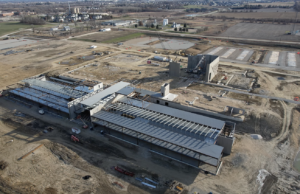Unequal Lives In the Cedar Valley

Waterloo-Cedar Falls metro area ranked no.1 worst place for African Americans to live
It’s not a No. 1 ranking for Waterloo-Cedar Falls that local officials want to celebrate. A recent article published by USA Today using data from Wall Street 24/7, rated the metro area of Waterloo-Cedar Falls at the top of the list of “worst cities for black Americans.” The article said the Cedar Valley metro area had the most “social and economic disparities along racial lines” in all of the United States. Black Hawk County Supervisor Chris Schwartz was not surprised. “Iowa has a lot to do to reverse the effects of systemic racism. When it comes to racial inequities, Iowa is always appearing on and off these various types of lists. I think that they are systemic problems that accumulated over time in Iowa,” he said. Cedar Falls and Waterloo have a long history of racial disparities going back to 1910s, when a large group of African Americans migrated to Waterloo from Mississippi to work for railroad companies. Oftentimes, the black workers were hired as strikebreakers. The African American population in Waterloo increased from only 24 in 1910 to 837 a decade later. Waterloo’s African American citizens were segregated into the neighborhood known as the “Black Triangle.” This section of Waterloo still is one of the poorest in the metro area. By the 1950s, 4 percent of Waterloo’s population was African American. A large portion of the African American workforce in Waterloo later went to work at the enormous Rath meat packing plant. African Americans currently number 12,085 in Waterloo-Cedar Falls, 7.1 percent of the metro area, according to USA Today. However, there is a historic disparity in black population between the two largest cities that still exists today. The U.S. Census Bureau estimates Waterloo’s population in 2017 to be 67,587, with 15.7 percent black residents. Cedar Falls, with an estimated population of 41,570, has only 2.3 percent black residents. The study ranked U.S. metro areas based on eight socioeconomic measures charting disparities of black residents. The factors included median household income, poverty, adult high school graduation, bachelor’s degrees, homeownership, unemployment rates, incarceration rates and mortality rates.The USA Today article noted that in Waterloo-Cedar Falls, black median income is $25,897 (46.8 percent of white median income), and unemployment is 23.9 percent for blacks, but 4.4 percent for whites, and the homeownership rate is 32.8 percent for blacks, while it is 73.2 percent for whites.Elected in 2016 as the first African American mayor of Waterloo, Quentin Hart said the study was “was a little disheartening,” but Hart said he thinks things are better than the study suggests. “ I started my job as mayor in 2016, and we put together a statewide team called the Minorities Disparities Task Force,” Hart said. The Task Force worked to gather data and to have outreach meetings to identify the barriers that Iowa can break down to alleviate racial disparities This also led to the Future Ready Iowa career program, of which Cedar Falls mayor Jim Brown was also a participant. “It is an initiative that I am a part of with Governor Reynolds and Mayor Hart and a handful of other people to help individuals have a path in our society, including minorities. What they are trying to do is grab these folks where they are and have them learn the skills that they need, Brown said. “The idea is to get people certified or licensed and to get jobs and to make more money and more marketable,” he said. Despite the efforts to decrease racial disparities in Iowa, a large portion of the problem remains in the justice system. “When you talk about the incarceration rates in Black Hawk County, let’s face it, you are really talking about Waterloo and Cedar Falls by population. We have a definite disproportion incarceration rate,” Black Hawk County Defense attorney Aaron Hawbaker said.
Hawbaker added that in Black Hawk County prisons, 51.2 percent is African American. “We have a [black] population by census of 9.4 percent. If you look at it from county to county, that isn’t entirely unique to us. Iowa is just bad that way, and we are neck and neck with Wisconsin in African American incarcerations,” he said. Black Hawk County is 4.2 percent of the population of the state of Iowa, but makes up 9.2 percent of the prison population.“One thing that Black Hawk County does distinguish itself in a bad way is that we incarcerate by rate far more people in Black Hawk County than any other county,” Hawbaker said. Hawbaker said that one of the sources of the problem is over-policing the metro area’s black population. “You can drive through Cedar Falls as a young white woman, and you got a license plate that is obscured or your car’s back brake light is broken, and nine out of 10 times, you aren’t going to get pulled over, but that is not true in certain neighborhoods with certain colors. In Waterloo we have people getting pulled over for obscured license plates, loud music and I actually saw someone get pulled over for underinflated tires once. That was in Cedar Falls, and they were African American,” he said.
Police tend to find crime where they look for it, Hawbaker said. “The reality is that it is kind of a Catch-22,” he said. “Those communities get policed more, and that policing more and pulling people over and having more interaction with the police is going to add more people into the system, which just doesn’t happen in white neighborhoods.” For Schwartz, there is a long list of reforms that would help resolve the racial disparities.
“We need to examine the war on drugs and start to treat addiction as a medical issue rather than a criminal justice issue, which is one of the leading causes with this disproportionate rate of African American incarceration. We also need training in every institution, whether it is law enforcement or educational, we need to have adequate training in the effects of privilege and how to identify systemic racism,” he said.
Since Hart’s election in 2016, Waterloo has made a number of moves to respond to the racial inequalities.
“There are still disparities that exist in the community, and it needs to open the eyes of the community about investing and supporting in the city. The people who have been locally involved know that we are working toward it,” he said.
Hart explained that the unemployment outlook in the metro area is better now than in the older data in the report. “With all of that data that was used in the article, things have changed, and now unemployment rate in Waterloo is 2 percent versus the 4.6 percent in Cedar Falls, which is significantly different than the data used in the article.”
Hart also cited several projects that he said will improve economic opportunities.
“We are redeveloping the Logan Plaza corridor, and we are working with the University of Northern Iowa. We are reaching out to North Side businesses to find out what support they need moving into the future,” he said.
Hart also noted a initiative with Hawkeye Community College to build homes and create a minority owned grocery store.
“It is a marathon and not a sprint. These problems were happening for a long time before I was in office, but now I am in the position as mayor to create the kind of change that can lead to African Americans and everyone to have success,” Hart said.









You must be logged in to post a comment Login